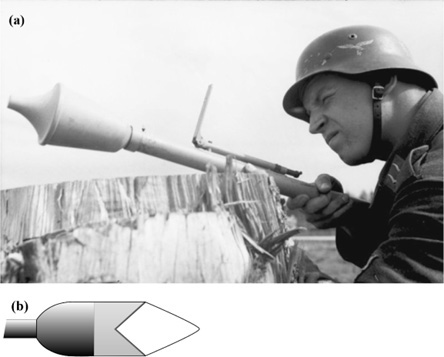
The purpose of a projectile weapon is, and has been since prehistory, to stop a target. To stop it from moving, from being able to hurt you, or from breathing. This purpose is not necessarily achieved simply by hitting the target; a sling stone may bounce off a leather jerkin, or a cannonball may bounce off the wooden sides of an Age of Sail ship.1 If this happens, then the projectile has failed in its purpose: no matter how skillful the shooter has been in launching and directing his missile to the chosen target, if the missile does not damage or incapacitate the target, then the whole exercise was a waste of time. As a consequence, since prehistory people have given thought to the effects of a projectile upon the target it hits and how these effects can be maximized. A sling stone made of lead may have a greater impact on an enemy soldier than one of stone, even through a leather jerkin. Heavier or faster cannonballs may have a more destructive effect on the hulls and masts of enemy ships.2
There may be more than one acceptable outcome from a ballistic projectile strike. Age of Sail ships were valuable prizes, so you, the captain of a frigate out to make a name and fortune for yourself by capturing enemy “prizes,” will destroy the enemy only if you cannot capture him. You do not want to smash his hull and sink him; you make use of specialized ammunition designed to achieve other purposes. Grapeshot (early shrapnel; think of a supersized shotgun cartridge) was used to sweep the decks of enemy crew while leaving the ship relatively undamaged; chain shot was used to bring down rigging and damage sails, thus hindering maneuvering by the target ship. Earlier in history, arrows were provided with different heads for different purposes. Flat arrowheads for penetrating flesh were given barbs so that they could not easily be pulled out. The deep wounds caused by an arrow could be made worse by dipping the arrowhead in dung before firing it, leading to infection. (A hunter after game would not use this tactic; it was suitable only for human prey.) Armor-piercing rounds, to use a modern phrase, took the form of conical bodkins that could punch through mail or plate armor.3
The modern period of gunpowder weapons has seen a proliferation of warheads and of scientific investigation into their penetrating and incapacitating power. The study of this last phase of a projectile’s trajectory, dubbed terminal ballistics, is a sufficiently mature discipline to have split into several specialized fields of study. In this chapter we will look at two of the main areas of interest: the terminal ballistics of a projectile (a specialized armor-piercing round) penetrating a metal target, such as a tank hull or turret, and the terminal ballistics of a bullet entering a human or an animal. The first area is part of the arms race that has been going on since World War II between armor-piercing weapons and armored vehicles; the second area is directed toward understanding the physiological effects of a bullet wound and their causes. In both cases the results of extensive study contain a few surprises and are of great interest to anyone who is curious about ballistics.
Throughout the years of World War II, tanks became heavier and heavier in response to antitank guns’ becoming larger and larger. It was found, as you might expect, that harder, tougher, heavier and more oblique monolithic plate armor is more resistant to high-explosive (HE) or solid-shot artillery rounds than softer, less tough, thinner steel plates that are presented face-on to the projectile trajectory. This is why tanks became heavier and with more angled plates. You may think that the guns would quickly win this race because there are obvious limits to the weight of a moving vehicle. Not so, however, because large antitank guns were very immobile, and this factor made them vulnerable to tanks and to enemy artillery in general. Towards the end of the war, a different kind of armor-piercing round came to the fore, the rocket-propelled grenade. We met RPGs in chapter 6; now it is time to look at the way that their shaped charges were able to punch through monolithic steel plates to disable tanks and other armored vehicles.
Figure 7.1a shows a World War II German soldier armed with the Panzer-faust antitank weapon, so effective against Soviet tanks during the final months of the war.4 The biconical shape of these warheads is seen in their modern equivalent, the shoulder-launched RPG (shown in fig. 6.7). There is a reason for this form, and it is connected with the shaped charge that provides the lethal punch.
In 1888 the American Charles E. Munroe, working for the U.S. Navy, discovered that a blast of high explosive could be made to concentrate or focus in a chosen direction by a suitable choice for the geometrical shape of the charge. This phenomenon is now known as the Munroe effect or the hollow-charge effect. Thus, a block of HE with a V-shaped groove cut in it would, when detonated, emit a blast that was concentrated in a plane emanating from the groove, instead of expanding in all directions. This is the basis of the linear-shaped charges used today by building demolition engineers to slice through structural steel columns. Imagine, now, what happens when the V-groove is replaced by a conical hole in the block of HE: the result is a blast that is concentrated along a line emanating from the hole. Because the blast is concentrated in this way, any material that is caught up in the blast is propelled to very high speeds and forms a jet.
The basic design of a shaped charge round is shown in figure 7.1b. The conical hole is lined with metal—usually copper—and when the charge detonates, this liner disintegrates, joining the jet. The pressure generated along the jet can reach 45 million psi, which accelerates the small particles of metal in a thin stream directly forward. Only about 20% of the metal liner forms this stream; the remaining 80% forms a relatively slow moving plug which follows on behind. The stream head reaches an astonishing speed of 8–9 km s-1 while at the tail the speed is about 1 km s-1. The plug trundles along behind at 300 ms-1.

Figure 7.1. World War II rocket-propelled grenades. (a) An early Panzerfaust RPG, here in the hands of a Luftwaffe soldier. Note the conical warhead. (b) Cutaway illustration of a shaped charge projectile.
How does the stream of very-high-speed copper particles punch through steel armor? Very easily. At the front of the stream, the particles have so much energy and momentum that steel armor looks like a fluid rather than a solid, and the stream just pushes it aside. One important feature of the shaped charges is that, to be effective, the charge must detonate a little distance in front of the armor. This (and aerodynamic streamlining) is the main purpose of the conical head. The charge detonates when the head comes into contact with the armor, and the empty space between charge and nose cone tip is enough for the copper stream to form.
High-explosive antitank (HEAT) round is the modern name given to the shaped-charge ammunition fired by Panzerfausts and bazookas. Since World War II the effectiveness of these rounds has improved a lot. They are devastating to the crew of a stricken tank because once the copper stream has punched a hole in the tank armor, metal particles (including spalling from the inside surface of the armor) spray the crew and can ignite ammunition. Modern HEAT rounds are fired from smooth-bore barrels because it was found that gyroscopically stabilized HEAT rounds are less than half as effective: centrifugal force acting upon the copper stream causes it to disperse. As a consequence, modern rounds are fin-stabilized.
Today, HEAT rounds can be fired from artillery as well as shoulder-launched infantry weapons; they can also be rocket-powered guided weapons. These developments mean that HEAT rounds now have longer ranges and higher trajectory speeds. The broad conical nose cone has been replaced by a much thinner tube, which acts as the spacer to ensure detonation at the correct distance from the target armor. At long range, guided missiles are the preferred weapon against main battle tanks (MBTs) and other armored vehicles. The light weight of rocket launchers and the small size of HEAT munitions mean that helicopters have become the deadliest antitank weapons platform. A helicopter can carry many HEAT rounds and can direct them from 4 km away down onto the top of an enemy tank, where its armor is weakest.
The Munroe effect and low cost have made HEAT rounds very effective weapons against tanks. The earliest responses to these weapons by tank crews was ad hoc and dates from World War II. There is a grainy old photograph of a Soviet tank during the Battle of Berlin in 1945 equipped with a hastily added metal cage placed along the side of the hull. (It is reported that Soviet tank crews resorted to covering their tanks with metal-spring mattresses looted from Berlin households to counter the Panzerfaust threat.)5 In the Vietnam War, American tank crews would enhance their defenses by adding sandbags to the hull and turret. Nowadays tanks and lighter armored vehicles may have spaced, or slat, armor, a more permanent and robust version of the earlier metal cages but using the same basic idea (fig. 7.2). Although cages, sandbags, and slat armor are not substantial enough to protect against a conventional HE round, they are effective against HEAT rounds because they cause premature detonation. The copper stream forms too far away from the steel armor and becomes dispersed, so that it loses much of its penetrating power.
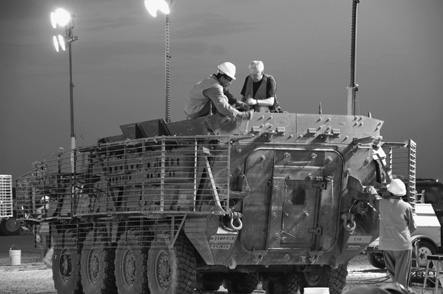
Figure 7.2. Slat armor on a Stryker combat vehicle. U.S. Army photo by Jim Hinnant, 401st Army Field Support Brigade.
Or that is the theory, but in practice this hiding-under-a-mattress approach does not always work. Tanks are very expensive, and HEAT rounds are not, so combatants faced with enemy tanks can fire large numbers of HEAT rounds and win, even if the success rate of an individual round is low. Tanks were losing the battle against HEAT missiles by the 1960s and 1970s, but tank designers responded effectively in two ways. The first approach, Chobham armor, added significantly to the burgeoning cost of MBTs, while the second, reactive armor, is an eloquent statement of the desperation to which tank designers were driven.
Chobham armor is a multilayered metal-ceramic armor that was first developed in the 1960s in England (Chobham is the English village nearest the research facility where this armor was invented) and later in the United States. It consists of very hard ceramic tiles encased in a steel matrix. The combination of hard, brittle ceramic with tough, ductile metal is difficult for the high-speed particle stream from HEAT missiles to penetrate—there are lots of surfaces to deflect the stream. Additionally, modern Chobham armor is backed by steel plate to hold the composite structure together and has shock-absorbing elastic layers. The M1 Abrams (fig. 7.3), the first MBT to be encased in Chobham armor, it is said to have been proven effective during the first Gulf War.
Chobham armor works best when an incoming antitank missile strikes it perpendicularly rather than at an angle. This is counterintuitive and goes against our experience with monolithic metal armor. We have already seen that the tanks of World War II were given sloped armor; this provided an increased thickness of steel to protect against nearly horizontal artillery shell trajectories and also perhaps served to deflect a solid-shot round. Chobham armor gives a tank a quite different look: note the steep sides of the Abrams. Many of the rules for tank armor design noted earlier (heavy, thick, oblique armor is better … ) do not apply to composite armored vehicles. Chobham armor weakens after it has been struck. Thus, even though the tank and crew survive a hit that would have destroyed one of the previous generation of tanks, they are vulnerable to a second hit in the same place.
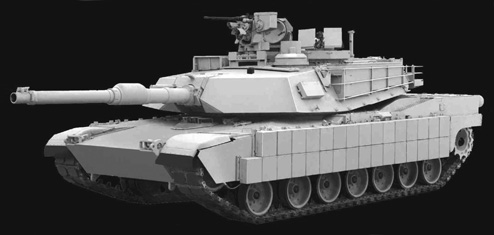
Figure 7.3. An M1 Abrams main battle tank. This tank weighs 61 tons, and its main armament is either a 105 mm rifled cannon or a 120 mm smoothbore cannon. U.S. Army photo.
Nowadays the hulls of tanks and other armored vehicles are given a Kevlar lining to protect crews from the spalling of the inside surface of a metal hull struck by an antitank round. Lighter vehicles are made from metals other than steel; for example, titanium is used for lightweight armored vehicles, while an aluminum-magnesium alloy is now common for U.S. armored personnel carriers and howitzers.6
Reactive armor consists of a jacket made up of explosive bricks that covers the metal hull and turret of a tank. Each brick is a sandwich of explosives between metal plates. Using explosives to defend against an HE or HEAT round sounds crazy, doesn’t it? The idea is that an incoming HEAT round would cause a reactive armor brick to explode; this explosion would be too small to damage the tank but would be enough to deflect the high-speed jet that HEAT rounds rely upon for penetrating armor. Reactive armor was invented independently in West Germany and the Soviet Union in the 1960s. Since then, a number of variants have been developed.
The type described here is called explosive reactive armor, predictably enough. It works quite well, but has two fairly obvious problems. First, it is often a good idea, tactically, to have troops accompany tanks into battle—but exploding reactive armor may result in casualties among one’s own infantry. Second, reactive armor is even more vulnerable than Chobham armor to a second hit in the same place. Designers of antitank missiles know this, and so they have come up with a tandem charge HEAT round. The first charge sets off the reactive armor on the tank; the second charge then sends the copper jet through the second layer of metal armor.
In recent decades another arrow has been added to the quiver of effective antitank rounds, taking the form of the long rod penetrator (LRP), a kinetic energy weapon that relies on mass and speed, not chemical energy, to burst through tank armor. Such weapons are cousin to the cannonballs of two centuries ago; when wooden sailing ships gave way to steam-powered ironclad warships, solid shot projectiles were retained, as the best bet for punching a hole through the armor. Rather than being round, however, LRPs are arrow-shaped because this is the most effective form, for reasons that will soon be seen. Some simple physics (Isaac Newton’s law of momentum conservation) is enough to paint us a broad-brush picture of what is going on here: it tells us that, in addition to being long and thin, the most penetrating projectile will be very dense and very fast (hyper-velocity is the Star Wars term commonly found in the technical literature). The Newtonian argument is summarized in technical note 21. While approximate, this argument must be close to the truth because the most effective way currently known for penetrating thick steel armor is with LRPs; they are increasingly taking over from HEAT missiles at the top end of the market.
LRPs are constructed from either tungsten or depleted uranium, both of which are about 19 times denser than water (and twice as dense as steel). They travel through the air like greased lightning: LRP muzzle speeds vary between 1,400 ms-1 and 1,800 ms-1—about one mile per second, or four or five times the speed of sound. A typical LRP is 2–3 cm in diameter (say, 1 in) and 50–60 cm long (20–24 in) and weighs about 4 kg (9 lb). I would not want to get in the way of one of these projectiles.
In addition to being more effective than HEAT missiles against tank armor, LRPs are more accurate, owing to their high speed. LRPs are fired from artillery guns, so how are such high muzzle velocities obtained for a small-caliber projectile? In fact, the artillery bore is much wider than the LRP diameter. Figure 7.4a shows a cutaway illustration of an LRP round; the shell casing is of much larger caliber (120 mm is typical) than the projectile. The LRP is held in place with a lightweight sabot (shown as dark grey in fig. 7.4a) that is discarded during flight to reduce drag, as shown in figure 7.4b. Note that the LRP has fins. This is because it wastes energy to provide the LRP with spin; the round is fired from a smooth-bore gun and stabilized with fins.
As you might expect, there has been a great deal of experimental and theoretical investigation into the subject of armor penetration by projectiles—how to increase it and how to reduce it. Part of this research has resulted in several empirical formulas that summarize how far a given missile can penetrate a steel plate. The subject is technically complicated, and no fully developed theories yet exist; hence the need for empirical formulas, based upon experimental tests. One of these, Lambert’s formula, is discussed in technical note 22. From this formula we can see how fast two different types of NATO bullets need to be in order to penetrate steel armor to a given depth; the results are shown in figure 7.5. We can also play around with the formula and find out how far two different LRPs will penetrate steel armor (fig. 7.6). Note how effective they are: it is possible for one of these high-tech arrows to punch through half a meter of steel armor.
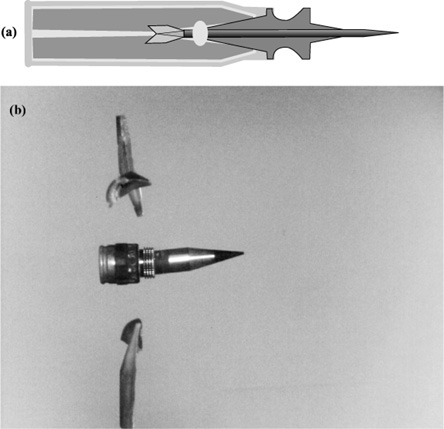
Figure 7.4. Long rod penetrators. (a) Cross section illustrating the LRP projectile, with fins and sabot attached inside the shell. (b) In flight, the sabot peels off the low-drag, hypervelocity projectile. Image from Wikipedia.
Finally, a word about the statistical nature of the empirical formulas. Such formulas arise from experimental tests, and the test results vary from sample to sample, leading to a distribution of missile speeds. Our formulas estimate the speed, ν50, that must be attained in order for 50 out of 100 projectiles of a specified type to penetrate steel plate to a specified depth; thus, ν50 is what statisticians call the median speed. If the same 100 projectiles are hurled toward the plate at a speed that is 15% lower, then perhaps only 10 of them will penetrate to the same depth; if their speed is 15% higher, then 90 will punch their way through.7
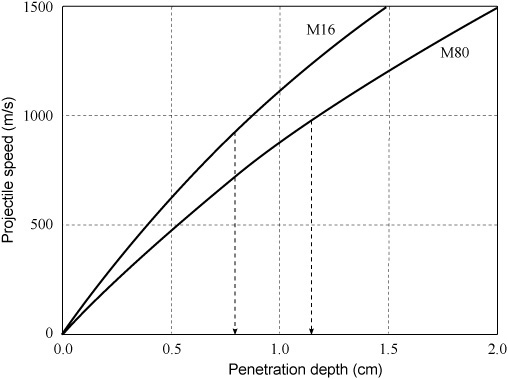
Figure 7.5. Speed required for two NATO rounds (fired from M16 and M80 rifles) to penetrate to a given depth of steel armor, estimated from Lambert’s formula. For the actual rifle muzzle speeds (dashed lines) we see that the bullets will penetrate a little more or less than 1 cm.
Tank leads to antitank weapon, which leads to tank armor designed to defeat the antitank weapon, which leads to improved antitank weapons—and so the arms race continues today. It seems ironic that the best modern antitank round harks back to the most effective projectile weapon of the fourteenth century—the arrow—if only in shape. The story is not yet over; this fight has several rounds to go (another pun—sorry). For what it is worth, my money is on the antitank weapons because they are inexpensive and because, to succeed, only one of them has to get through.
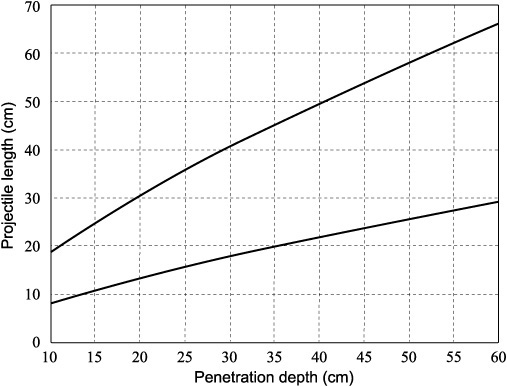
Figure 7.6. Projectile length vs. penetration depth for two LRPs fired at steel armor, estimated from Lambert’s formula. The upper curve is for a 2-cm-diameter projectile striking the armor at 1,200 ms-1; the lower curve is for a 3-cm-diameter projectile moving at 1,700 ms-1.
I will begin by knocking down the “knockdown” myth. Many people believe that there is enough momentum in a bullet, even a handgun bullet, to knock a man down. This belief is bolstered, no doubt, by many of the less-cerebral action movies that show a bad guy getting shot while standing still—and then he flies backward over a table or through a window. This is Hollywood, not reality. Yes, a person who has been struck by a bullet may double up, or suddenly twist or turn, but this is a physiological response; it is a twitch that can alter body shape but not move the body’s center of mass across a table. Your getting shot in the chest with a .22 cal bullet when wearing soft body armor is equivalent, in terms of momentum transfer, to being hit in the chest by a baseball moving at 40 mph. It hurts—it leaves a bruise—but you are nowhere close to being knocked down. Let’s up the ante by saying that you take a hit from a .45 caliber round: that is equivalent to being struck in the chest by a 90-mph baseball. You may hop about in pain, but you are not incapacitated or knocked down. Plenty of major league baseball players get hit by 90-mph baseballs without getting knocked over.8
Another example: the force from a 9 mm handgun bullet is about the same as that from a 1-pound weight falling from a height of 6 feet. Such a force is not going to knock you down. But suppose a more powerful rifle bullet did have sufficient force to push you over. Then Newton’s third law tells us that the reaction force would also knock over the shooter. The movies get it wrong.
So is momentum transfer an insignificant factor in assessing the damage caused by bullet wounds impacting on human flesh? It seems that momentum is a key factor. The impact depth of a bullet correlates better with bullet momentum than it does with bullet kinetic energy. Kinetic energy transfer was an important consideration in penetrating steel armor, but the situation is not so clear in the (in some ways more complicated) assessment of wound damage. A bullet that passes straight through a person may cause less damage than a slower bullet that remains inside the body because the fast bullet transfers less momentum (and less kinetic energy) to the body.9 On the other hand it may cause more damage, depending upon its shape and speed: as we will see, exit wounds can be much bigger than entrance wounds.
The correlation of a bullet’s stopping power with its kinetic energy is uncertain. There are several theories of wound physics (a complex enough subject to warrant its own international organization, the International Wound Ballistics Association). Some assert that kinetic energy is the crucial component of ballistic wound damage, while others assert that shock waves are the real killer. To provide you with an early historical example that displays the difficulty in reaching a clear-cut (that’s almost another bad pun) conclusion, consider again the Minié ball.
You may recall from chapter 3 that the Minié ball was the first bullet-shaped bullet; it made rifled muskets much more effective weapons than the older smooth-bore muskets. Civil War soldiers knew that the Minié ball tore an enormous wound on impact and that an abdominal or a head wound would almost always be fatal.10 Later, during the Spanish-American War, U.S. military doctors noticed that the wounds caused by the then-standard Krag-Jorgenson rifle were less damaging than wounds of 30 years earlier caused by a rifled musket firing Minié balls. Modern analysis confirms this observation. From a range of 10 feet, .58 caliber Minié balls were fired from a rifled musket into a block of ballistic gelatin (modeling human flesh). From the same range, full-metal-jacketed .30 cal bullets were fired into gelatin from a Krag-Jorgenson. The Minié balls weighed 458 gr and traveled at 944 ft/s, whereas the rifle bullets weighed 219 gr and moved at 1,852 ft/s. The Minié created a large temporary cavity in the gelatin (121 mm diameter), whereas the rifle bullet caused a 39-mm temporary cavity. Conclusion: the rifled musket would cause more severe wounds in human targets.11
Hmm. We have to be a little careful here before drawing conclusions:
• Ballistic gelatin is not human flesh. It does model the fluid-dynamical way that flesh responds to bullet penetration, but it can say nothing else about wound damage.
• Temporary cavity size—the maximum extent of the hole blown into a body—used to be considered the main indicator of wound damage, but now researchers are pretty sure that it isn’t. We will see that there are many other contributors to wound damage in human tissue.
• The momentum of the two types of bullets is about the same. The kinetic energy of the .30 caliber bullet has twice the kinetic energy of the Minié. How can these facts be reconciled with the damage observed?
The lesson to take away from this introduction to ballistic wounds is that it is not easy to interpret results and come to firm, cut-and-dried conclusions.
There are a few general observations that can be made concerning the nature of bullet wounds. First the observations, made appropriately as bullet points, and then the discussion:12
• Bullets from rifles are more damaging than those from handguns.
• At the same velocity, large-caliber bullets are more damaging than small-caliber bullets.
• Expanding bullets are more damaging than non-expanding bullets.
• Inelastic organs are more susceptible to bullet damage than elastic organs.
• Pressure waves or shock waves that emanate from high-velocity bullets entering the body can cause significant damage at some distance from the wound site.
There are four components of projectile wounding, and the above observations fit into one or more of these components: temporary cavity, permanent cavity, penetration, and fragmentation. A temporary cavity results from the fluid dynamics of a projectile entering a body—either a human body or a block of gelatin. The large hole that results from kinetic energy transfer lasts a brief period of time before closing over. Due to the elasticity of organic tissue, the temporary cavitation effects are not long term and are usually not fatal. However, some human organs are less elastic than others, and these suffer more damage, particularly if they are of high density. Thus, the brain, the liver, and the spleen are more prone to be significantly damaged by a bullet wound than are the low-density and very elastic lungs, for example.
The permanent cavity is the hole left by the bullet. It is the track of tissue damage that occurs due to crushing and laceration as the bullet forces its way through the body. Handgun bullets tend to crush tissue and organs because of their large caliber. The volume of the permanent cavity correlates with bullet damage: bigger permanent cavities result in more damaging wounds.
To produce a large-volume permanent cavity, a bullet must penetrate deeply as well as be high caliber. This is why handgun wounds are often not as severe as rifle wounds: the combination of high caliber and low speed means that handgun bullets do not penetrate very far (but see fig. 7.7). Bears are hunted with rifles, not handguns, because a bullet needs to penetrate deeply in order to find the vital organs of a bear: a handgun bullet would just get it annoyed, which is not a good idea.
Fragmentation is a way of spreading the damage—increasing the permanent cavity and perhaps hitting a vital organ. Shotgun rounds fragment in the barrel and spread out during their trajectory; they do damage over a large area and can penetrate some distance at short ranges, causing massive damage. Other bullets are designed to fragment on impact, again doing significant damage. They dump their energy into tissue, instead of penetrating right through and taking a lot of energy with them, doing little damage unless they hit something vital. Soft-nosed and especially hollow-point bullets increase the size of the permanent cavity they create by deforming upon impact.13 This effect is known as mushrooming because of the resultant bullet shape.
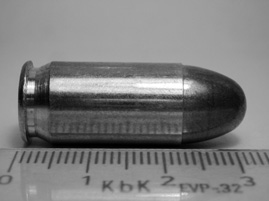
Figure 7.7. A full-metal-jacket .45 cal automatic Colt pistol (ACP) round. Designed over a century ago as a “man-stopper,” these rounds penetrate deeper than soft-nosed bullets (the jacket prevents mushrooming); this and the large caliber lead to a big permanent cavity wound. The ruler is marked in centimeters. Image from Wikipedia.
Mushrooming effectively increases the bullet caliber when it is inside the target. A low-caliber bullet can retain a lot of its muzzle velocity because it is less susceptible to aerodynamic drag over the course of its trajectory than is a high-caliber bullet. But if this low-caliber bullet is a hollow-point, then it mushrooms into a high-speed, high-caliber bullet inside a person, causing massive damage, as evidenced by the massive exit wound from such a round. Many hunting rifles fire bullets that deform in this way, but they are banned against humans in warfare by the Hague Convention of 1898. A low-power, small-caliber rifle used to hunt vermin benefits from hollow-point bullets; the low power means that little penetration occurs, but this is not so important for small prey. The mushrooming effect ensures a humane, quick kill. Other bullets are designed to resist deformation (e.g., full-metal-jacket military rounds). These penetrate deeper and are more effective against large game, such as elk or people.14
Another way that a bullet can increase its effective caliber, and thus increase the size of permanent cavity it creates (and so the damage it does), is by tumbling through tissue. If a bullet strikes bone, it may cause bone splinters to shoot out, acting like bullet fragments and doing secondary damage; but in addition, the bone may cause the bullet to tumble. As with mushrooming rounds, tumbling increases area and so helps to dump bullet energy into surrounding tissue, thus increasing the crushing and lacerations that are a feature of damaging wounds. Unlike bullets that mushroom, it is not illegal to use tumbling bullets against humans (after all, you can’t expect the shooter to avoid hitting bones). The M16 rifle fires low-caliber rounds (.223) designed to tumble and produce large surface wounds.
High-velocity rounds striking tissue generate pressure waves (up to 200 atmospheres) and perhaps shock waves that propagate far from the wound track and can cause significant damage. For example, they can burst fluid-filled organs such as the heart, the vascular system, the bladder, and the bowel. (Such hydrostatic shock effects become dramatically credible if you see high-speed movie images of bullets striking soft fruit or full soft drink bottles.)15 Neural damage also results from pressure waves, particularly from rifle rounds.
For an artillery battery, terminal ballistics is about more than the effects of munitions on the victims. We have already seen two examples (MRSI and sound-and-flash) of artillery tactics used to locate targets; there are many others, of course. Before even firing a salvo, however, the battery commander (you, let’s say, just for the next few paragraphs) has to consider terminal ballistics because he needs to assess the target and choose an appropriate type of round that will achieve his object. The purpose of launching an artillery salvo against an enemy position is to achieve one of three levels of disablement—suppression, neutralization, or destruction. Suppression means that you are obliging the enemy to keep his head down: while you are firing at him, he is unable to function because he is too busy avoiding damage. Neutralization means he has suffered enough damage (10% casualties) to cause him to temporarily abandon operations after you have ceased firing. Destruction means just what it says: permanent loss of function (in practice this may mean 30% casualties).
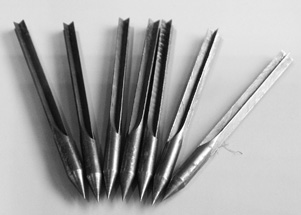
Figure 7.8. Flechettes. These date from World War I and are 4 inches long. Modern flechettes are dispersed from beehive artillery rounds and are a quarter to a third of this length. Image from Wikipedia.
These three levels represent an increasing intensity of fire and an increasing commitment of time and resources. How best to achieve the desired goal? Making this decision requires target assessment. Artillery targets are rarely uniform. You may be dealing with infantry out in the open or a line of trucks. The target may be a mixture of advancing armor and infantry, or a stationary group of buildings with dug-in guns and crews.
You make your assessment and choose appropriate ammunition. HE shells are very effective against infantry; high-explosive rocket-assisted (HERA) shells achieve the same results at a longer range; beehive rounds (fig. 7.8) are more effective if your targets are in the open.16 Chemical rounds will choke or blister enemy personnel or cause damage to nervous systems; mines can be scattered from artillery rounds, denying ground to the enemy; smoke may mark his position or screen friendly positions from his view. Having chosen ammunition, you must decide the best method of attack. What aiming points? (Your targets may be distributed widely and unevenly.) What density and duration of fire? Having delivered your salvos you quickly move on (“shoot and scoot”) to avoid counterfire, which nowadays can arrive very quickly, thanks to remote sensors such as radar. For this reason, the primary indirect fire support weapon today is the self-propelled howitzer (in the U.S. Army, the M-109 155 mm). If you are not mobile you must disperse and dig in, or else the terminal ballistics will be at your end of the shell trajectories.
In World War I more casualties were caused by artillery than by small arms, in marked contrast to the American Civil War, showing how artillery had come of age in the two generations that separated those conflicts. Artillery retains its dominance in the ethnic conflicts of today.17
Bullets are aimed at individuals; an artillery round is meant to kill many people. HE rounds cause casualties by blast and by fragmentation. The blast—the bang, flash, and flame—is local and fatal if you are caught in it. Casualties increase if the blast occurs in a confined space, say inside a tank or inside a building (due to structural collapse as well as the effect of concentrated blast pressure). The pressure wave can kill you without leaving a mark. Fragmentation spreads lethality further afield. The fragments may be contained within an ordnance round, or they may be parts of the exploding shell, as the projectile body is broken up by the HE blast. Fragments travel at high speed (around 1,000 ms-1) and are lethal to personnel, though they do only superficial damage to most hard targets. Thus, the “50% range” (the radius within which half the people are killed) for a 105 mm HE shell is roughly 50 feet (100 feet for a 155 mm shell). There is an optimum fragment size of 1.4 g (1/20 of an ounce). Any smaller and the fragments are slowed down too much by aerodynamic drag and so their lethal range is limited; any larger and the number of fragments is reduced so that casualties are reduced. As with many aspects of war, artillery casualties are statistical in nature—a fact of interest to munitions developers and military doctors but not, perhaps, to the casualties.
We have examined two aspects of terminal ballistics: armor penetration and wound damage. Toward the end of World War II, HEAT rounds fired from man-portable launchers were very effective at penetrating steel armor, because of the Munroe effect of shaped charges. Tank designers adapted by making armor thicker and more sloped. In the 1960s Chobham armor and reactive armor were invented. These techniques prevented, or perhaps only delayed, the eclipse of tanks as effective battlefield weapons. Missile designers countered by developing tandem-charge HEAT rounds and LRPs—and so the arms race between missiles and armor continues. Empirical formulas estimate the median speed required for an LRP or a bullet to penetrate steel armor.
Most bullets do not have enough momentum to knock down a person. Estimating the severity of a wound caused by a bullet from the bullet’s characteristics is not easy, and the process of causing wound damage is not completely understood. Wound severity is known to increase with bullet caliber and speed, and is worse for expanding bullets. It correlates better with bullet momentum than with bullet kinetic energy. Pressure waves caused by bullets can do much damage at sites far from the bullet track.